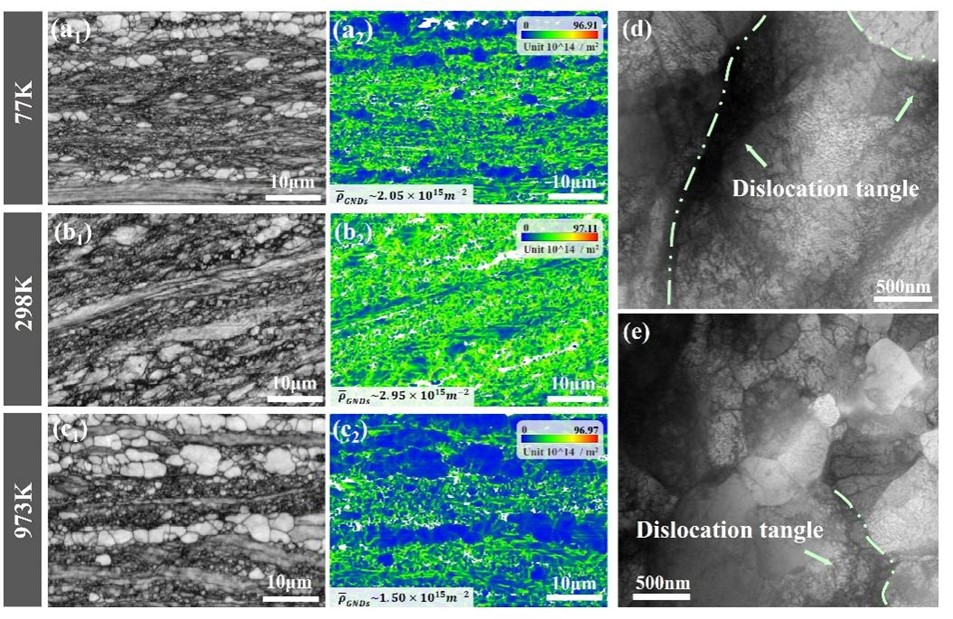In aerospace, nuclear energy, and advanced manufacturing, structural materials must operate reliably from cryogenic to high temperatures. Conventional alloys face a persistent strength–ductility trade-off: strengthening typically comes at the expense of tensile elongation, and high-temperature strength degrades sharply. Refractory high-entropy alloys (RHEAs)—composed of high-melting elements such as Nb, Ta, Mo, W, and Hf—offer promise for elevated-temperature service, yet achieving simultaneously high strength and high ductility across a broad temperature window remains challenging. Heterostructured metals, which can activate heterogeneous deformation–induced (HDI) strengthening, have emerged as a pathway to address this dilemma.
Building on this concept, the team led by Professors Jun Ding and En Ma at the State Key Laboratory for Mechanical Behavior of Materials / Center for Alloy Innovation and Design (CAID), Xi’an Jiaotong University, designed a cold-workable Nb–Ta–Ti–Hf–based refractory high-entropy alloy (nominal composition: Nb₄₃.₂Ta₂₇Ti₁₃Hf₁₅Re₁.₅B₀.₃). Through a cold-rolling plus annealing thermomechanical route, the researchers established a thermally stable heterogeneous grain structure comprising nanocrystalline/ultrafine grains, fine grains, and retained deformation grains, thereby producing a graded mechanical response (Fig. 1). Tensile tests show an ultimate tensile strength >1.8 GPa with ~10% elongation at 77 K, and a tensile strength >900 MPa at 973 K, setting a new benchmark among single-phase solid-solution–type alloys. In-situ mechanical probing and microscopy reveal that the superior performance stems from the HDI mechanism: strain partitioning between soft and hard regions and dislocation accumulation at interfaces generate back-stress and forward-stress hardening, which sustains a high work-hardening rate (Fig. 2). Notably, this mechanism operates effectively not only at room and cryogenic temperatures but also persists at 973 K.
The study demonstrates, for the first time, robust HDI strengthening up to 973 K, challenging conventional expectations. Equally important, the heterostructure remains stable after prolonged annealing at 973 K, attributable to the alloy’s high melting point and sluggish diffusion in the multi-principal system. These attributes enable microstructural and mechanical stability at high temperature and articulate a transferable alloy-design strategy: tuning microstructural heterogeneity to realize strength–ductility synergy across temperature regimes. The findings provide guidance for next-generation structural materials intended for extreme environments.

Figure 1. Microstructure of the heterostructured RHEA and its tensile properties across a broad temperature range.

Figure 2. EBSD and TEM characterization of fracture specimens tested at different temperatures for the heterostructured RHEA.
The work, entitled “Thermally stable heterogeneous-grained refractory high-entropy alloy offering superior strength from 77 to 973 K,” was recently published in Nano Letters. The State Key Laboratory for Mechanical Behavior of Materials, XJTU, is the primary corresponding affiliation. Yaqiong An (PhD candidate, School of Materials Science and Engineering, XJTU) is the first author; Professor Jun Ding, Professor Cheng Zhang (Tianmushan Laboratory), and Professor Robert O. Ritchie (University of California, Berkeley) are co-corresponding authors, with additional contributions from Professor En Ma (School of Materials Science and Engineering, XJTU). The research was supported by the National Key R&D Program of China, the National Natural Science Foundation of China, and national Young Talent programs.
Article link: https://pubs.acs.org/doi/10.1021/acs.nanolett.5c04691
Professor Jun Ding (homepage): https://jdmse.github.io/zh/


